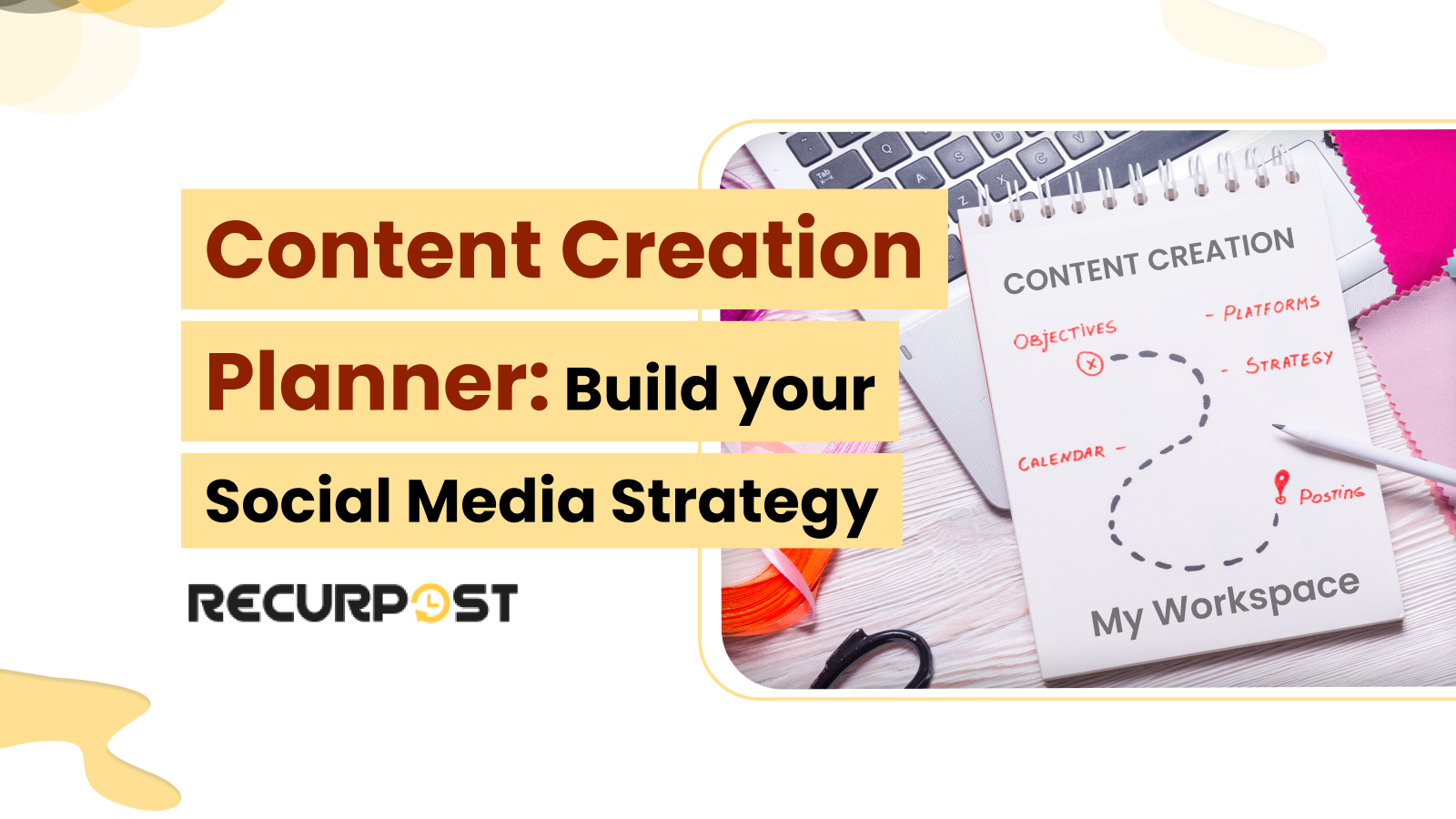Managing multiple accounts can consume over 10 hours weekly, but a content creation planner cuts that workload by 70% and boosts engagement by up to 40%.
A content creation planner works as a social media assistant and content scheduling tool. It saves hours, organizes posts, and keeps multi-platform management smooth. Marketers, freelancers, coaches, and real estate agents all benefit from its time-saving structure and audience engagement boost.
With a content creation planner, social media feels less chaotic. You’ll see how it supports brand consistency, campaign alignment, and smarter scheduling. From template libraries to performance analytics, the right planner gives you control, not clutter.
What is a Content Creation Planner?
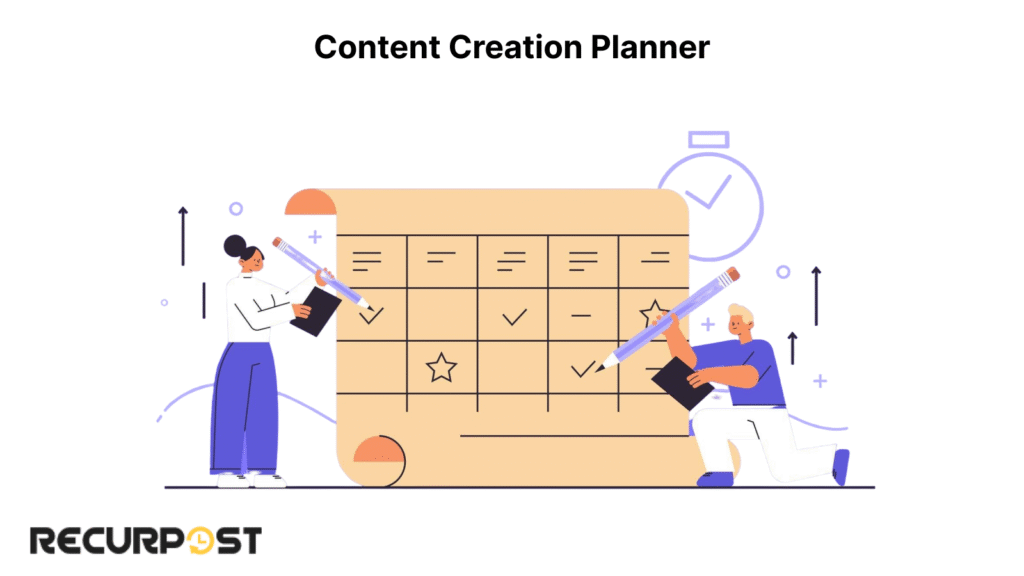
A content creation planner acts like a social media assistant. It plans, schedules, and tracks posts across multiple platforms from one hub. The tool organizes your workflow, automates publishing, and cuts last-minute stress.
Core Features of a Content Creation Planner
- Scheduling Tools
Scheduling Tools let you plan days, weeks, or months ahead. The planner publishes posts when your audience is most active.
- Multi-Platform Support
This means managing Instagram, Facebook, Twitter, LinkedIn, and TikTok from one dashboard. This gives you a clear view of all accounts.
- Performance Analytics
Performance analytics show how each post performs. They reveal engagement drivers and guide better planning for future content.
- Collaboration Features
Collaboration tools support calendar sharing, approvals, and team planning across locations. This makes teamwork smoother and posting consistent.
- Template Libraries & Customization
Template libraries speed up creation with ready-made designs. Customization keeps content aligned with branding while saving time.
Why a Content Creation Planner Matters
A content creation planner streamlines workflows, cuts planning time, strengthens content quality, and maintains brand consistency across single or multiple accounts.
For businesses managing multiple accounts, choose a content creation planner with multi-platform support: Instagram, Facebook, LinkedIn, TikTok, and Twitter. This saves time and keeps posting consistent.
Content Repurposing Tips for Maximizing Social Media Strategy
Repurposing content extends reach. A social media content planner helps turn one post into captions, graphics, videos, and updates across platforms.
One blog post becomes captions, videos, and graphics across platforms, keeping a steady presence without constant new ideas.
A content creation planner saves time with bulk scheduling. It fills calendar gaps and maintains cross-platform content mixes for balance.
Tip: Use free templates in your content creation tool to quickly repurpose and adapt content for different platforms. This helps you plan ahead and stay on track with your marketing efforts.
Why Does a Clear Social Media Plan Matter?
Posting without a content planner limits growth. A clear social media strategy strengthens brand presence, connects with target audiences, and turns followers into customers while keeping posts visible against competitors.

The Role of Social Media in Driving Business Growth
Social platforms fuel business growth. A content planner gives freelancers, SMEs, and real estate professionals access to audiences on Facebook, Instagram, and LinkedIn.
With the right social media planning, you can:
- Build brand recognition with a content planner
- Drive traffic to your website or landing pages
- Engage with customers in real time through structured content scheduling
- Boost conversions and sales by aligning posts with audience behavior
Optimizing Your Social Media Calendar for Consistency and Engagement
A social media content planner organizes and schedules posts across platforms. It maps campaigns in advance and keeps content consistent.
A content calendar maps posts ahead, maintains cross-account consistency, and organizes holiday campaigns when engagement potential peaks.
With a content creation planner, consistency drives long-term growth. Timely posting keeps brands active and connected. A content planner balances organic traffic with paid campaigns to align with marketing goals.
Tip: Use content planning tools that support team collaboration to ensure that all team members are on the same page when filling in gaps in the calendar. Content audits will also help you track which posts performed well and which didn’t, so you can refine your approach.
What Happens Without a Plan?
Unplanned posting creates inconsistency, misses opportunities, and confuses audiences. Poorly planned content may:
- Posts look disjointed or out of place without a content planner.
- Unstructured content often struggles to engage the intended audience.
- Missing planned dates means skipping key moments like holidays or trending topics, something a planner avoids.
- Inconsistent posting lowers engagement rates, making follower growth harder, a gap that a content planner can fill.
Without planning, social media efforts go to waste, and expected results never arrive.
Key Stats: The Impact of Posting Frequency on Engagement
Consistent posting schedules boost engagement, as shown by these statistics:
- Brands that post 16+ times a month on Facebook see 3.5x more engagement than those who post less frequently.
- Posting regularly on Instagram (at least 5 times a week) leads to higher follower growth and more likes per post.
- On LinkedIn, businesses that post 2-4 times a week get 3-5x more engagement than those posting less often.
[Source: Social Media Statistics]
The above data shows that regular posting at optimal times drives growth.
Visualizing Success: A Sample Content Calendar
A content calendar organizes posts by platform, date, and time using planners like RecurPost. This keeps posting consistently.
Example: A 30-day calendar could include content like:
- Week 1: Brand awareness posts introducing a new product or service
- Week 2: Customer testimonials or success stories, scheduled with a content planner, help build trust.
- Week 3: Educational content (how-to videos, blog post links)
- Week 4: Promotions highlighting special offers or discounts
This keeps content fresh, messaging clear, and audiences engaged.
Tip: Content planner helps you stay consistent! A content creation planner makes it easy to post regularly, eliminating the stress of scrambling for last-minute content. With tools like RecurPost, you can plan ahead and maintain that consistency without breaking a sweat.
How a Content Creation Planner Enhances Your Social Media Campaigns
Well-organized campaigns go beyond timely posting. A content creation planner streamlines workflows and lifts campaign quality across multiple platforms.
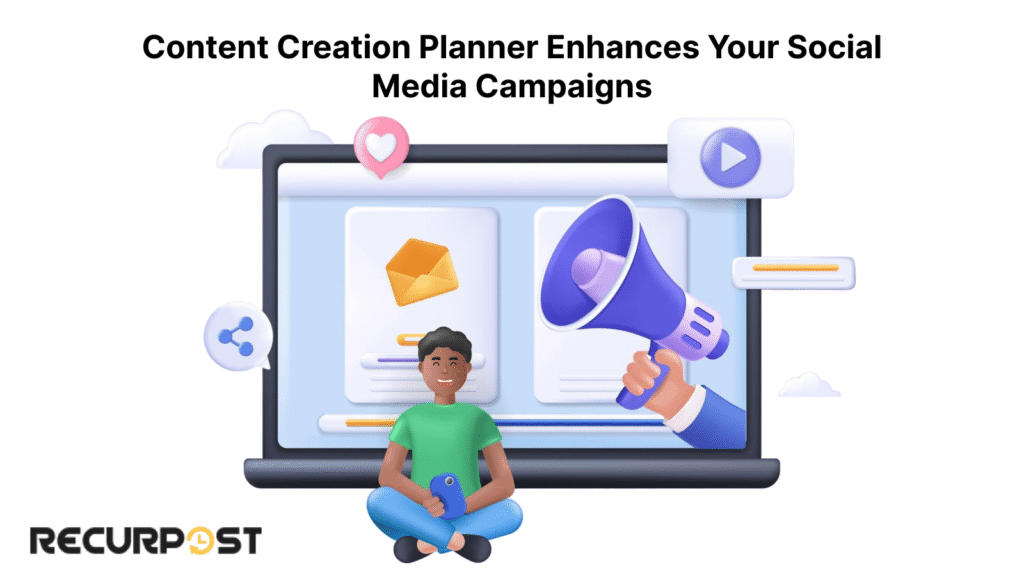
Time Efficiency
A content creation planner saves time. By planning posts, you avoid last-minute stress. Instead of daily uploads, you can engage with your audience or track campaign performance.
Weekly or monthly content planning improves time use and enables bulk creation during productive periods instead of constant last-minute posting.
Boosting Engagement
Advance planning lifts engagement by creating audience-aligned content that matches interests and encourages interaction.
A content creation planner schedules varied content: educational posts, promotions, user-generated updates, and behind-the-scenes looks, sustaining interest and engagement.
Tip:Use performance analytics to see which content drives engagement. Adjust future posts to increase interaction.
Improving Content Quality
A content creation planner supports purposeful posts that reflect brand voice and goals by avoiding rushed creation.
Whether posting images, videos, or text, planning ahead lets you:
- Keep consistent messaging
- Stay on-brand across platforms
- Create high-quality posts aligned with business goals
Content Planner for Multi-Account Management
A content creation planner helps digital marketing agencies and freelancers manage multiple accounts in one place, simplifying scheduling, analytics, and team collaboration.
For example, Tools like RecurPost let managers handle several client accounts from one dashboard, avoiding platform switching or losing track of posts.
Brand Consistency
A content planner supports consistency across platforms, which builds trust. A content creation planner ensures posts align with overall messaging and visual style, no matter the platform.
Planned content maintains cohesive tone and visuals. Whether shared across platforms or styled differently, posts remain consistent and on-brand.
Campaign Alignment
Every post should connect with broader goals: traffic, awareness, or conversions. A content creation planner keeps posts aligned with campaign objectives.
For instance, launching a new product: use your planner to schedule teasers, then share reviews or behind-the-scenes updates to keep excitement alive.
Tip: A content creation planner aligns posts with larger goals like traffic, sales, or brand growth. Monitor the planner’s analytics to refine planning and strengthen results.
How to Create and Execute a Social Media Strategy with a Planner
With clear content planning, you can create posts that meet marketing goals and strengthen presence across platforms.
Step 1: Create Content that aligns with your brand and target audience.
Step 2: Use your tool to schedule posts ahead of time at optimal times.
Step 3: Use content ideas from trends, holidays, and feedback.
Step 4: Keep consistency with a planner that integrates multiple platforms.
A social media plan should create quality posts that provide audience value. This drives organic traffic, boosts engagement, and supports marketing goals.
Tip: Track post performance regularly. Adjust planning using insights from your content calendar to keep campaigns effective.
Choosing the Right Content Creation Planner for Your Business
Not all planners bring the same benefits for social media management. Selecting the right content creation planner streamlines workflows, saves time, and strengthens campaign quality. With many choices available, how do you find the best Content planner?
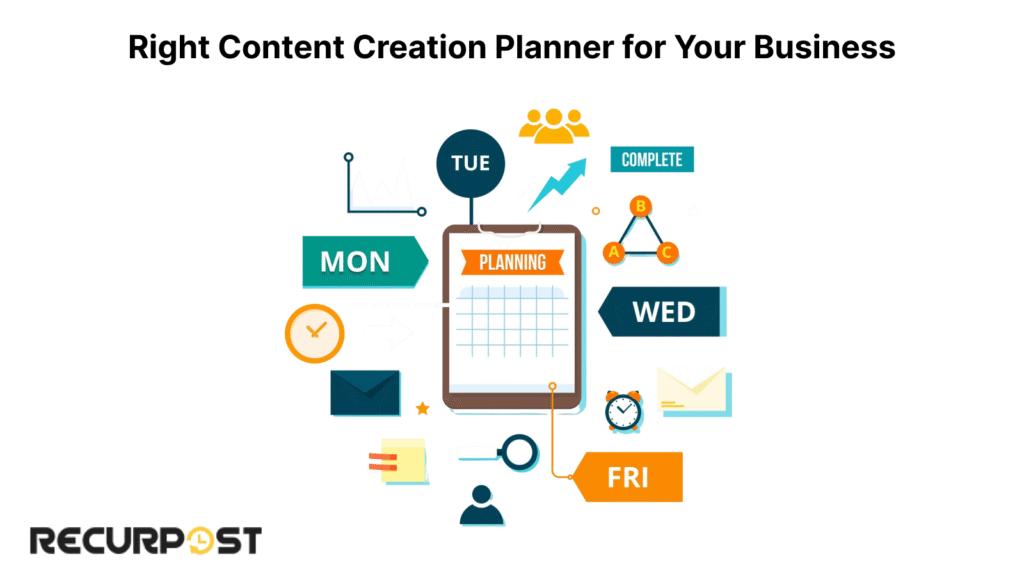
Key Features to Look For in a Content Creation Planner
Pick a content creation planner by focusing on features that add the most value for your business. Here’s what to look for in a content planner:
- Scheduling Tools
Scheduling posts ahead is vital. Choose a planner that lets you queue content for multiple platforms, ensuring posts publish at optimal times for engagement.
- Collaborative Features
For teams, select a planner with collaboration tools: shared calendars, approvals, and task assignments. These features simplify teamwork for agencies and larger businesses.
- Analytics Dashboard
Tracking performance shapes better planning. A strong dashboard reveals post data like engagement rates, click-throughs, and follower growth, helping refine future content.
- Platform Compatibility
A content creation planner should support Instagram, Facebook, Twitter, and LinkedIn. Many also manage TikTok or Pinterest. The more platforms supported, the smoother your process.
- Integration with Social Media APIs
A strong planner integrates with social media APIs, syncing accounts directly. This avoids manual uploads and prevents compatibility issues.
How RecurPost Works as a Content Creation Planner
RecurPost stands out among content creation planners with features that make it stronger than many tools in the market.
- Content Library & Recycling
Unlike many planners, RecurPost includes a content library to store and categorize posts. It also supports automated content recycling, resharing top-performing posts automatically. This feature saves time and effort in content creation.
- Analytics & Insights
RecurPost provides detailed performance analytics across platforms. This data helps refine content planning, lift engagement, and strengthen ROI.
- Affordability & Value
RecurPost is often more affordable than Buffer or Hootsuite without reducing features. As a content planner, its unique pricing structure delivers strong value for businesses and freelancers.
- User Testimonials
Businesses and freelancers find RecurPost easy to use. Many mention saving time with automation and reusing high-performing posts through the content library. Managing multiple accounts from one dashboard also gets frequent praise.
RecurPost Compared with Other Content Planning Tools
Here’s a quick look at how RecurPost stacks up against other popular content creation planners:
| Feature | RecurPost | Buffer | Hootsuite |
| Multi-Platform Support | Yes | Yes | Yes |
| Content Recycling | Yes | No | No |
| Content Library | Yes | No | No |
| Analytics Dashboard | Yes | Yes | Yes |
| Team Collaboration | Yes | Yes | Yes |
| Pricing | Affordable | Moderate | Expensive |
As shown, RecurPost includes unique features like content recycling and a content library, saving time and making social media planning more efficient.
Tip: When selecting a content creation planner, think about needs like multi-account management, collaboration, or content recycling. RecurPost is a strong choice for businesses needing a cost-effective tool with powerful features in content planner.
When to Hire Content Creation Professionals
While content creation planners simplify social media, some businesses benefit from hiring professionals to build a content creation plan. This is valuable for teams lacking social media experience or needing specialized planning.

When to Consider Hiring Content Creation Services
Hiring content professionals makes sense in several cases:
- Limited Internal Resources: If your team lacks time or skills to build a content creation plan, professionals fill the gap so you can focus on operations.
- Specialized Industry Knowledge: Experienced creators add insights on audience behavior, trending topics, and platform-specific practices
- Scaling Content Operations: For multiple accounts or new platforms, external professionals design scalable content systems and workflows.
What to Look for When Hiring Content Creation Professionals
When reviewing content services, consider these factors:
- Portfolio and Case Studies: Check past work for engagement growth, follower gains, and conversion lifts.
- Platform Experience: Ensure they know your active platforms, like Instagram, LinkedIn, TikTok, or others.
- Strategic Approach: Skilled creators go beyond posts, building plans aligned with business goals and audience needs.
- Tool Proficiency: Confirm they use content creation planners like RecurPost, Buffer, or Hootsuite, so they can set up long-term systems.
Questions to Ask Potential Content Creation Partners
Before hiring, ask these questions to confirm alignment with your content planning process.
- How do you research and define target audiences?
- Which content creation planner tools do you recommend and why?
- Can you share examples of content calendars you’ve built?
- How do you measure content performance and adjust planning?
- What’s your process for brand voice development and consistency?
Tip: Whether handled internally or outsourced, a content creation planner like RecurPost remains valuable. Professionals can design systems and strategy, while you use the planner to maintain consistency and track performance.
Building and Implementing Your Social Media Strategy with a Planner
Now that you know what a content creation planner is and why it matters, here’s how to build and execute your social media plan. It begins with clear objectives, audience insights, and an organized content calendar.
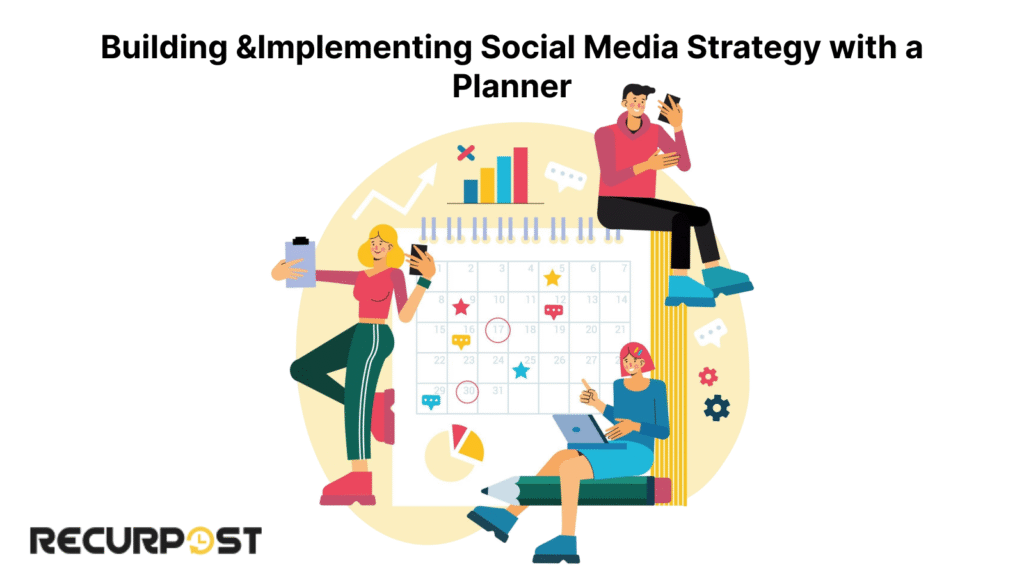
Step 1: Set Clear Objectives
Before scheduling posts, define why you’re posting. Do you want more brand awareness, website traffic, leads, or sales? Setting measurable goals is the first step toward building a successful social media plan.
When using a content creation planner, typical objectives include:
- Brand Awareness: A content planner helps more people recognize your brand
- Lead Generation: A content planner helps in attracting potential customers.
- Community Engagement: Creating meaningful interactions with followers.
- Sales: Planner helps in driving traffic to product pages and converting visitors.
Having a clear goal in mind will help you tailor your content to meet these objectives. For instance, sales-focused posts might include calls-to-action, while engagement-focused posts could be polls or questions, both managed in a content creation planner.
Step 2: Know Your Audience Through Planner
Audience insights shape your social media plan. To create content that resonates, analyze:
- Demographics: A content planner helps tailor posts by age, gender, and location.
- Interests: Using a planner, you can align content with what your audience cares about most.
- Engagement Patterns: A content creation planner shows when your audience is active and what posts earn attention.
With tools like RecurPost, you can track which content types perform best. This guides future posts and ensures you deliver what followers expect.
Step 3: Develop a Content Calendar
A content calendar is your roadmap. It details what, when, and where to post. Using a content creation planner, you can schedule across platforms and avoid gaps.
Here’s an example of a 30-day content plan:
- Week 1: Brand introduction with behind-the-scenes posts, your brand story, and testimonials organized through the planner.
- Week 2: Educational content, such as tips, how-to guides, or news, structured in your planner.
- Week 3: Product or service promotions, discounts, and offers scheduled consistently with the planner.
- Week 4: Community engagement content like polls, Q&As, or user-generated posts managed within the planner.
Tip: Use RecurPost’s content calendar to view your month at a glance. This avoids gaps and keeps planning organized.
Step 4: Create Engaging Content
With a plan set, create content that captures attention. A varied mix scheduled through a planner keeps audiences engaged. This includes:
- Visual Content: Eye-catching images, graphics, and videos.
- Blog Posts: A planner helps in sharing valuable, in-depth articles that drive traffic and provide insights.
- User-Generated Content: Reviews, testimonials, or customer photos.
- Interactive Posts: Polls, quizzes, and questions for interaction made through the planner spark audience engagement.
RecurPost organizes these content types, ensuring variety in your content calendar and balanced scheduling.
Step 5: Automate Posting
Once content is ready, schedule it. Automation keeps posting consistently without requiring constant device time. With a content creation planner, schedule posts days, weeks, or months in advance.
For example, use RecurPost’s scheduling tool to publish at optimal times. Create content when free and let the tool handle posting.
Step 6: Track and Adjust with a Planner
The work continues after posts go live. Use analytics in your content creation planner to monitor engagement, reach, and click-throughs.
If a post performs well, share it again using RecurPost’s content recycling. If not, adjust planning based on data insights.
Tip: Audit your content calendar regularly to fill gaps and adjust based on performance. A content creation planner simplifies this and keeps you ahead.
Automating Your Content Creation and Posting
Time matters in social media management. A content creation planner automates your content plan and posting, saving you hours of manual work. But what does that involve, and why is it valuable?
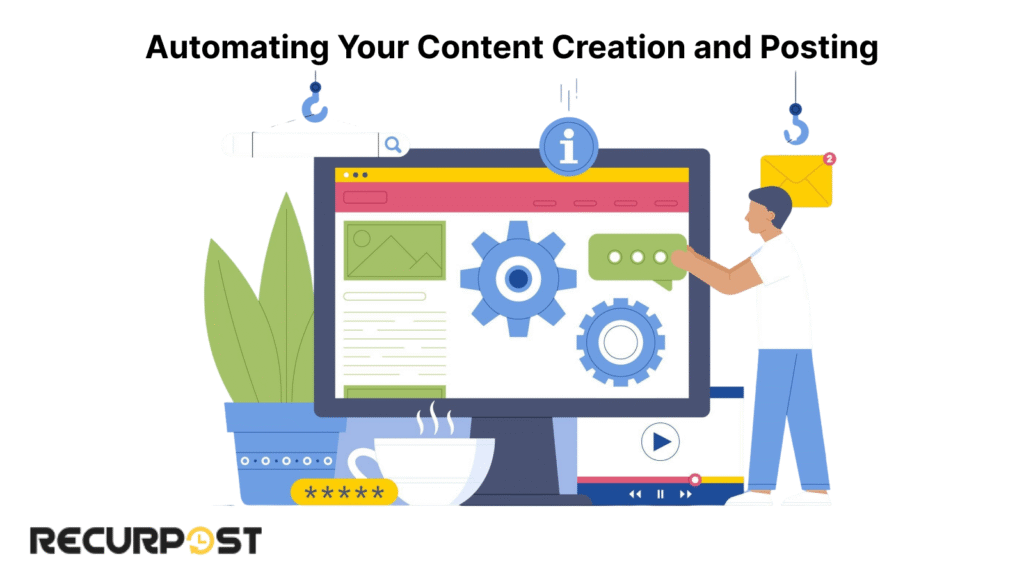
What Is Content Automation?
Content automation is scheduling and posting ahead of time. A content creation planner lets you prepare posts in advance, and the tool handles publishing automatically.
Why is Content Automation so useful?
- Saves Time: No need to be online all day. Once planned, posts publish automatically.
- Consistency: Posts go live at the best audience times.
- Reduced Stress: Automation with a planner removes last-minute pressure and keeps posting on track.
Automation in the content planner works like autopilot. Build a content plan for the month in one session, then let the planner handle the rest.
How to Use Automation for Social Media
Steps to start content planner automation:
1. Plan Your Content: Create your posts in advance: images, videos, captions, hashtags, and links.
2. Schedule Posts: Use the content planner to assign dates and times.
3. AI-based posting times: RecurPost’s feature schedules posts when audiences engage most.
4. Content Recycling: RecurPost reuses top posts automatically, keeping content fresh.
Tip: Check insights to learn when your audience is active. Tools like RecurPost use data to automate posting at peak times for maximum reach.
Best Time to Post on Any Social Platform
Reach more people by posting when your followers are most active.
This tool uses AI to scan platform-specific data and your audience behavior to recommend the exact times your content will perform best—across all major social channels.
⭐ 4.3/5 average user rating (based on 2,000+ reviews)
Advanced Automation Features of a Content Planner
Some content creation planners, like RecurPost, offer even more advanced automation features:
- Bulk Scheduling: Upload hundreds of posts in one batch. Instead of adding them one by one, schedule in bulk and distribute them across the month. This is a time-saver for businesses with heavy posting needs.
- Social Listening: Tools like RecurPost monitor trending topics so you can adjust content quickly. Social listening keeps posts relevant and responsive to popular conversations.
- Auto Post Across Multiple Channels: Automating across platforms ensures content reaches audiences on their preferred networks without extra effort. This is especially helpful for businesses managing multiple accounts.
Saving Time with Automation of the Planner
Automation of the planner saves more than the posting time. It frees hours otherwise spent brainstorming ideas or manually updating calendars. Here’s how automation of the content planner helps:
- Content Planning: Plan weeks or even months of posts in a single session.
- Time Management: Instead of daily scrambling, batch-create content when convenient and schedule it for optimal times.
- Hands-Off Posting: Let the content creation planner handle publishing while you focus on other business priorities.
RecurPost’s bulk scheduling and AI-based posting times save up to 5–7 hours weekly, tailoring automation to business needs.
Tip: While automation of planner saves time, check in on posts. Engage with your audience, reply to comments, and refine planning from performance. Automation supports your content plan, but authentic interaction still matters.
Conclusion
A content creation planner does more than schedule posts; it strengthens social media efforts and builds a consistent online presence. Whether you’re an SME, freelancer, coach, or managing multiple accounts, this tool saves time, lifts engagement, and keeps you aligned with business goals.
By organizing content in advance, using automation, and tracking with performance analytics, managing social media becomes easier and more structured. Tools like RecurPost let you plan, create, and manage seamlessly, while saving hours each week.
Now is the right time to organize your content plan. If you’re not using a content creation planner, try one and see how it reshapes your social media management.
Ready to take your social media planning further? Try RecurPost today and see the difference a content creation planner makes for your business.
Frequently Asked Questions
1. How does a content creation planner help with idea generation?
A content creation planner supports idea generation with templates and content suggestions. It also tracks performance analytics, showing which formats work best so you can create similar posts.
2. Can I automate the posting process entirely with a content creation planner?
Yes. Tools like RecurPost let you schedule posts in advance. The planner publishes at optimal times, so you save time and focus on other tasks.
3. What if I don’t know the best time to post on social media?
Many content creation planners, like RecurPost, use AI-based posting times to suggest when your audience is most active, helping lift engagement.
4. Is it necessary to have a content creation planner for small businesses?
Not mandatory, but very useful. A content creation planner in a small business helps streamline posting, saves time, and boosts engagement — making social media easier to manage in one place.
5. Can a content creation planner help with post consistency across multiple platforms?
Yes. RecurPost and similar tools manage posts across platforms from one dashboard, keeping content consistent without switching accounts manually.
6. How do I know if my content creation planner is helping my social media growth?
A reliable content creation planner includes analytics to track engagement, reach, and other metrics. Reviewing this data shows growth and guides adjustments.
7. How can I involve my team in using a content creation planner?
Many planners include collaboration features like shared calendars and task assignments. Teams can work together, approve posts, and maintain a unified plan.
8. How do I choose between free and paid content creation planners?
Paid options often include advanced analytics, multi-platform support, and content libraries. If you need these, a paid plan is worthwhile. Free planners suit basic needs.
9. What happens if my content planner doesn’t integrate with my social media platforms?
Without integration, you may need manual uploads. Choose a content creation planner that syncs with your main platforms for smooth posting.
10. How often should I review my social media strategy with a planner?
Review monthly or quarterly. Use your planner’s performance analytics to refine posts and confirm your content plan supports business goals.

As a passionate content writer, I love blending creativity with research to craft compelling narratives that inform, engage, and inspire. With a strong focus on user engagement and brand communication, I create content that resonates with the audience and drives meaningful interactions.

